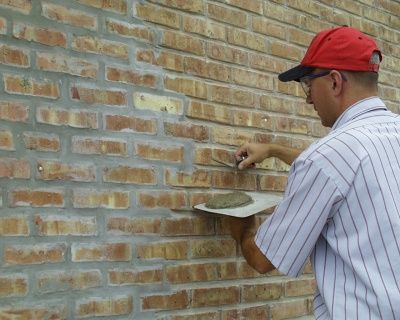Facade Restoration -
Facade Repair, New York
Introduction to Facade Restoration and Repair
Without a doubt, the facade of your building is its beauty, or, at the very least, it gives onlookers an impression of it. Maintaining the exterior of your building is critical for aesthetics, structural integrity, and financial value. However, facade damage can occur over time from weathering, pollution, movement, and more. Over time, this can cause cracking, discoloration, and damage. While this is inevitable, it doesn’t mean it should be overlooked. Without proper restoration, facade damage can lead to water infiltration, structural issues, and accelerated decay.
As a building owner, you have to ensure your building still retains that posh look. Regular facade repair and maintenance preserves a building’s appearance and prevents costly future issues. And if you want to get the job done right, you need the best and most experienced hands. This is where Keystone Brownstone Restoration comes in. Our experienced team has been providing top-quality facade restoration, facade repairs, and cleaning services in this area for several years. We use only the highest quality materials and advanced techniques to ensure your building’s facade lasts for decades to come.

Understanding Facade Deterioration
To understand what makes the facade of your building decline over time, you have to know the factors in play and the signs of deterioration.
Factors Affecting Façade Integrity
-Weathering: Constant exposure to rain, sun, wind, and temperature fluctuations causes erosion, fading, cracking, and deterioration over time.
-Pollution: Dirt, soot, and chemical pollutants in the air can discolor and slowly damage facade materials.
-Water Infiltration: Cracks, deteriorated sealants, and poorly maintained flashings allow water into the facade, leading to rot, rust, spalling, and structural issues.
-Movement: Shifting, vibration, and settlement of the building structure apply stress to the facade, resulting in cracking and separation.
-Inadequate Maintenance: Allowing facade problems to go unchecked leads to accelerated decay and deterioration. Lack of cleaning and sealing also reduces lifespan.
-Improper Repairs: Low-quality materials, unskilled workmanship, and disregard for original architecture further damage the facade.
-Salt Crystallization: Water evaporating from facades leaves salt deposits which grow crystals that crack and spall masonry.
-Vegetation: Roots, vines, and runoff patterns can damage surfaces, joints, and flashing.
-Vandalism: Human destruction and defacement of facades through graffiti, throwing objects, etc.

Signs of Deteriorating Facades
Watch for these signs to determine if exterior wall refurbishment is needed:
- Cracking: Cracks in masonry, stucco, and stone indicate structural movement or material fatigue and deterioration.
- Discoloration: Dirty, stained, or uneven-colored surfaces show weathering and contamination of the facade.
- Spalling: Flaking, pitting, and cracking of masonry surfaces caused by water infiltration and freeze/thaw cycles.
- Efflorescence: White powdery deposits on masonry from water evaporating and leaving mineral salts behind.
- Mold & Mildew: Dark staining and organic growth caused by prolonged moisture exposure.
- Peeling Paint: Paint flaking or peeling away reveals multiple layers of deterioration underneath.
- Ornament Loss: Missing or crumbling decorative details indicate advanced decomposition of materials.
- Mortar Erosion: Crumbling, missing, or cracked mortar joints lead to water intrusion and structural instability.
- Plant Growth: Roots, vines, and vegetation damage facades by forcing apart materials.
- Rust Staining: Rust leaching from metal facade components shows advanced corrosion issues.
- Leaks: Water leaks, drips, and damp spots signal flashing sealant, and drainage problems.
- Bulging: Masonry bulging or displaced from the structure indicates instability and deterioration
Facade Restoration NYC Techniques
We have two kinds of techniques for residential or commercial building restoration:
Historic Facade Preservation Techniques
With our traditional facade restoration, we’ll use time-honored materials and methods to repair, restore, and maintain historic building exteriors.
Repointing: We carefully scrape out damaged joints and replace them with matching historic mortar to restore structural integrity and weather resistance.
Masonry Patching: We selectively replace deteriorated masonry units like brick, stone, and terra cotta with materials that match the originals.
Cleaning: We use gentle cleaning methods like low-pressure water washing to remove soiling while preserving patinas and architectural details.
Paint Removal: With chemical strippers or gentle media blasting, we’ll remove failing lead paint while avoiding damage to historic substrates.
Modern Facade Restoration Approaches
With newer materials and advanced techniques, we execute effective facade restoration that maintains your building’s historic character.
Crack Injection: We inject epoxies and grouts into cracks and voids to rebond masonry and concrete units.
Coatings: With advanced polymer coatings. We’ll provide waterproofing and protect masonry from deterioration. This allows surfaces to breathe.
Composite Repair: Our top-quality fiberglass and carbon fiber reinforcement is used to structurally repair and strengthen damaged architectural features.
Laser Cleaning: We use highly controlled lasers to remove soiling while eliminating damage and waste from traditional sandblasting.
Residential Facade Repair Issues & Tips
Maintaining the appearance and structural integrity of your home’s facade requires a proactive approach and proper repair techniques to ensure lasting results. Below are some essential tips to help address common facade issues:
Cracking: Cracks in the facade not only affect aesthetics but can also lead to further structural issues if left untreated. To repair these, we’ll apply flexible sealants and epoxy injections specially formulated to expand and contract with the building’s natural movement and settlement. This approach ensures that the repair is durable and can withstand changing weather conditions.
Spalling: Spalling, where parts of masonry crumble or detach, often occurs due to moisture penetration or environmental stress. Our team carefully removes any loose, deteriorated material before patching it with masonry that matches the original. To strengthen the repaired area and prevent further spalling, we use advanced consolidation treatments to re-bond weakened surfaces.
Water Damage: Water infiltration can cause extensive damage, particularly if left unaddressed. Our first step in treating water damage is to locate and fix the source of moisture intrusion, whether from leaks, faulty gutters, or poor drainage. Once identified, we replace any rotted wood and thoroughly seal the affected areas to prevent further water entry, preserving the facade’s durability.
Peeling Paint: Peeling paint can detract from your home’s curb appeal and expose underlying materials to the elements. To resolve this, we meticulously prepare and prime the surface, ensuring optimal adhesion for the new coat. We then repaint using high-quality, exterior-grade paint, which provides additional protection from the sun, rain, and temperature changes. This step is crucial in enhancing the facade’s aesthetic appeal and longevity.
Deteriorated Siding: Siding can become damaged over time due to weather exposure, impacting both appearance and insulation. We assess each plank to determine if repair or replacement is needed. By using compatible materials that blend seamlessly with the existing facade, we ensure the repair maintains the original aesthetic while reinforcing the structure’s resilience.
Incorporating these repair methods into your maintenance routine can significantly prolong the life of your home’s exterior, keeping it both beautiful and structurally sound for years to come.
Preservation and Maintenance Guidelines
Here is a brief guide for facade preservation:
Routine Maintenance Practices
- We address issues proactively by inspecting facades yearly for cracks, damage, and needed repairs.
- Our team of professionals cleans surfaces regularly using proper methods for each material. Avoid damaging patinas. This is good for exterior wall maintenance.
- We reapply protective coatings and water-repellent treatments every 5-10 years.
- We ensure sealants and flashings are in good condition to prevent water intrusion.
- When vegetation begins to touch the facade, we prune them back and clear drains and gutters.
Preservation Guidelines for Historic Facades
- We use the gentlest means possible for cleaning, repairs, and modifications.
- We match existing materials and methods to preserve architectural integrity.
- We ensure the modifications meet standards.
- At Keystone Brownstone Restoration, we document facade conditions thoroughly before undertaking work.
- We repair rather than replace damaged features whenever possible.
Most Common Questions
How often should building facades be restored?
Facades should be restored every 10-20 years to maintain integrity and prevent water damage. Harsher climates or poor original construction may require facade restoration every 5-10 years. With annual inspections, we can help you to determine when your facade needs restoration.
What are the costs involved in facade restoration?
Costs vary based on building size, level of deterioration, and restoration techniques, but ranges from $10-$30 per square foot. Multi-story commercial buildings often cost over $300,000.
Can I perform DIY repairs on a deteriorating facade?
Minor cracks and peeling paint can be DIY, but facade restoration requires professionals in historical materials and preservation techniques. Improper facade repairs can cause further damage.
What materials are commonly used in facade refurbishment?
Masonry, stone, stucco, metals, wood, fiberglass, epoxies, sealants, and high-performance coatings.
How to find a reliable facade restoration contractor?
Seek experienced contractors with proper licensing, training, references, and examples of past restorations. Get multiple bids and check references thoroughly.
Conclusion
To ensure the highest quality in facade restoration, we provide comprehensive brick pointing and restoration services that not only enhance the aesthetic appeal of your building but also strengthen its structural integrity and extend its lifespan.
Our team is skilled in preserving the historic beauty of structures while using advanced techniques to address any wear and tear. Additionally, we offer expert masonry cleaning services, meticulously removing stains, dirt, and pollutants to restore your building’s original charm and brilliance, leaving it looking as good as new.
